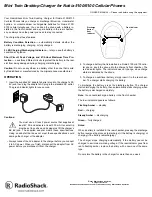
P a g e
|
9
ENERGIZER
BATTERY
MANUFACTURING
VERSION
1.2
Lower
Temperature
Conditions:
Air
holds
less
moisture
as
temperature
decreases,
and
the
difference
between
low
and
high
relative
humidity
becomes
less
significant.
At
0°C,
the
difference
between
the
humidity
of
the
PP355
and
the
environment
is
negligible.
While
the
service
obtained
from
a
PP355
at
temperatures
lower
than
standard
conditions
is
less,
the
loss
is
similar
to
Alkaline
batteries.
In
general
the
“up
to
3X”
service
advantage
for
Zinc
Air
batteries
over
Alkaline
batteries
is
maintained.
Figure
9:
Service
Summary
for
Zinc
Air
Prismatic
Batteries
at
Various
Environmental
Conditions
Humid
(35°C / 75% RH)
Typical
(21°C / 50% RH)
Arid
(35°C / 25% RH)
Cold
(0°C)
50 mW
Continuous
45 hrs
(2 days)
38 hrs
(2 days)
40 hrs
(2 days)
12 hrs
(0.5 days)
50 mW
1h per 12hr
38 hrs
(19 days)
36 hrs
(18 days)
30 hrs
(15 days)
16 hrs
(8 days)
50 mW
1h per 24hr
25 hrs
(25 days)
30 hrs
(30 days)
17 hrs
(17 days)
-
A
AAA
Alkaline
50 mW
5 hrs
(0.25 days)
PP
35
5
generally about 12 hrs (0.5 days)
for these temperatures and all intermittencies
Each
battery
was
exposed
to
the
specified
conditions
for
the
entire
test
duration.
Figure
9
demonstrates
the
service
obtained
from
a
PP355
battery
at
35°C/75%
RH,
35°C/25%
RH,
and
0°C
conditions.
The
data
presented
with
units
of
hours
represent
the
runtime
that
the
battery
delivered,
while
the
values
in
parentheses
indicate
the
duration
of
the
test
in
days.
In
summary,
the
PP355
battery
sustains
a
significant
performance
advantage
over
similar
volume
Alkaline
batteries
with
varying
intermittency
in
extreme
temperature
and
humidity
conditions.
2.3
‐‐
Pulse
Capability
The
pulse
capability
of
Zinc
Air
batteries
is
dependent
on
the
instantaneous
amount
of
oxygen
available
at
the
air
electrode
at
a
given
time.
While
the
PP355
battery
can
continuously
discharge
at
rates
up
to
100
mA,
the
battery
can
provide
significantly
more
current
in
short
bursts.
Figure
8
demonstrates
that
a
fresh
PP355
battery
can
provide
pulses
of
up
to
1500
mA,
depending
on
the
duration
of
the
pulse.
The
pulse
capability
of
a
Zinc
Air
battery
can
also
be
affected
by
the
frequency
of
the
pulses.
Pulse
capability
will
drop
over
time
without
sufficient
time
for
more
oxygen
to
enter
the
air
electrode.



































